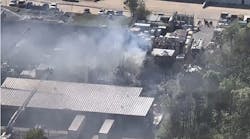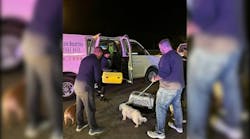On Wednesday, Dec. 5, 2007, a four-alarm fire destroyed the Indeco Sales and Maco Manufacturing facility in Belton, TX. The 106-employee company manufactured and sold library equipment and classroom furniture. The large, century-old building was used for manufacturing, storage, shipping and a showroom. The fire department faced numerous challenges from the beginning of the incident, including the potential for wall collapse and a sizable fuel load of flammable liquids and hazardous materials.
The original building was constructed in 1890 with several additions being added over the years. The buildings were constructed of stone, masonry and steel. The roof structures were steel I-beams covered by a built-up flat roof. The total size of the connected structures was 330,000 square feet. The entire facility was piped for a sprinkler system, but only one fire department connection (FDC) was present. All post indicator valves were painted over and fire officials were unable to determine whether they were open or closed.
The Belton Fire and Rescue Department was dispatched at 10:20 A.M. to a reported structure fire at the facility. Engines 1 and 2, both 1,250-gpm pumpers; Quint 2, a 75-foot aerial ladder with a 1,500-gpm pump; and ALS Medic Units 1 and 2 responded with seven firefighters and Assistant Fire Chief Bruce Pritchard under the command of Fire Chief Roy Harmon. At the time of dispatch, mutual aid from the Temple Fire and Rescue Department was requested for one engine.
Upon arrival, Belton firefighters found heavy, black smoke coming from the southeast corner of the roof. A company representative informed Harmon that the fire was in the area of a room that stored paint and large amounts of flammable liquids and hazardous materials. Quint 2 was positioned at the northeast corner of the building and set up for aerial master-stream operations. This unit was supplied by a 700-foot, five-inch line laid by Engine 2 from a hydrant at Fifth and Birdwell. Engine 1 laid 100 feet of five-inch line from a hydrant at Fourth and Birdwell to the front of the building. Firefighters laid a three-inch line from Engine 1 to the FDC to supply the sprinkler system. Temple Engine 3 was positioned at the southeast corner of the complex.
Interior Attack
Belton firefighters stretched a 200-foot three-inch blitz line with a gated wye from Quint 2 to an area near the Paint Room. Two 1¾-inch pre-connects were placed into operation from this blitz line. Temple firefighters pulled two 1¾-inch pre-connects from Temple Engine 3 and entered the building to assist Belton crews with a coordinated interior attack. From this position, interior firefighters could not reach the seat of the fire due to building construction and evacuated the building within 10 minutes.
Pritchard requested an additional ladder truck from Temple at 10:30 A.M. Temple Ladder 1, a 75-foot aerial ladder, responded with six firefighters. Temple also dispatched the Regional Hazmat Truck with three firefighters. This unit screened and tested air and water quality throughout the incident. Temple Ladder 1 was positioned on the southeast side of the building and set up for aerial-stream operations. This aerial was fed by a 700-foot five-inch line from a hydrant at Sixth and Continental that was laid by Temple Engine 3.
Belton Training/Safety Officer Leroy Vargus was in charge of scene safety during the incident. Temple Public Information Office Thomas Pechal was responsible for providing information to local and regional news agencies. Temple Fire Chief Lonzo Wallace was in charge of Temple firefighting operations.
School Evacuation
Harmon initiated the evacuation of two nearby schools early in the incident due to heavy, toxic smoke in the area. Belton Intermediate School District staff members were responsible for the evacuation. One hundred eighteen students were evacuated from Waskow High School and 539 from Tyler Elementary School. All students were transported by school buses to Belton High School and placed in the gymnasium for the remainder of the day.
Harmon requested mutual aid from the Harker Heights Fire Department at 10:40 A.M. Harker Heights responded with Quint 2, a 75-foot aerial ladder with a 2,000-gpm pump, and a Regional Command Vehicle with six firefighters under the command of Fire Chief Jack Collier. The Fort Hood Fire Department, 35 miles away, responded on the fourth alarm with Truck 1, a 110-foot aerial ladder with a 1,250-gpm pump, and Tanker 1, a 2,250-gallon tanker, with seven firefighters under the command of Assistant Chief of Fire Prevention Bill Welter.
Area volunteer departments were also asked to respond on the fourth alarm with tankers and brush trucks. The Salado Volunteer Fire Department responded with Tanker 3, a 2,300-gallon tanker, and Engine 4, a 1,000-gpm pumper; the Troy Volunteer Fire Department responded with Tanker 1, a 5,000-gallon tanker; the Little River-Academy Volunteer Fire Department responded with Tanker 1, a 1,800-gallon tanker; the Southwest Volunteer Fire Department responded with Tanker 1, a 1,500-gallon tanker; the Morgan's Point Volunteer Fire Department responded with two brush trucks; the Stillhouse Volunteer Fire Department responded with an engine for station coverage in Belton; the Nolanville Volunteer Fire Department responded with an engine to the scene; and the Moffat Volunteer Fire Department responded with a brush truck and was assigned to extinguish spot grass fires. Bell County Fire Marshal Steve Casey was assigned command of the tanker-shuttle operations and brush truck operations.
Harker Heights Quint 2 laid a 400-foot five-inch line from a hydrant at Third and Birdwell and was positioned at the southeast corner of the building. This unit placed its aerial master stream into operation. Firefighters opened up the east wall and found fire raging above the sprinkler system. Crews advanced a hoseline from Harker Heights Quint 2 and placed it into operation to stop the fire progression into this warehouse.
Belton Quint 2 was repositioned to a more strategic location at the front of the complex as the fire continued to spread out of control. A 200-foot five-inch supply line was laid to a hydrant at the northwest corner of the complex to supply Quint 2. Salado Engine 4 supplied Harker Heights Quint 2.
Water Shortage
At 4:30 P.M., the public works director alerted Harmon that the water supply in the municipal water tower was critically low. A tanker shuttle was established with tankers from hydrants in Temple, three miles away. A drop tank site was established at the northeast corner of the complex. Water was supplied to Belton Quint 2 and several portable monitors.
Harmon declared the fire under control at 5:26 P.M. and most mutual aid units were released by 9 P.M. Belton, Fort Hood and Temple units remained on the scene throughout the night extinguishing flare-ups. Sixty-six firefighters responded with 25 pieces of apparatus. Four million gallons of water was required to extinguish the fire. All of Belton's elevated water towers were depleted, requiring a boil-water order. Texas Commission for Environmental Quality officials were on scene to analyze water runoff for contaminants. Weather at the time of the incident was fair and warm with a temperature in the mid-70s with a three- to five-mph wind. There were no injuries to civilians or firefighters.
A three-day investigation into the cause and origin of the fire was conducted by the Belton fire marshal; State of Texas fire marshal; Bureau of Alcohol, Tobacco, Firearms and Explosives (ATF); and Harker Heights and Killeen fire marshals. The cause was determined as accidental. The fire caused an estimated $5 million in damage to the building and $5 million in damage to the contents.
Post-Fire Analysis
Water supply was the biggest problem during this incident. Alternative water supplies are needed for big incidents. Firefighter accountability required the use of two resources, as two systems had to be used. The career departments use an electronic system, where the volunteer departments use a manual system.
Most importantly, there were no injuries to any of the personnel involved in the incident. Mutual aid departments supplied the additional resources necessary to control the incident. Even though this was a large-loss fire, it was contained to the building of origin. Additional training has been addressed with classes on master-stream usage and fighting fires in large structures. Building pre-plans will be kept on the apparatus in the future.
JAY K. BRADISH/IFPA, Firehouse® news editor, is a former captain in the Bradford Township, PA, Fire Department. He has been a volunteer firefighter and fire photographer for more than 25 years.





